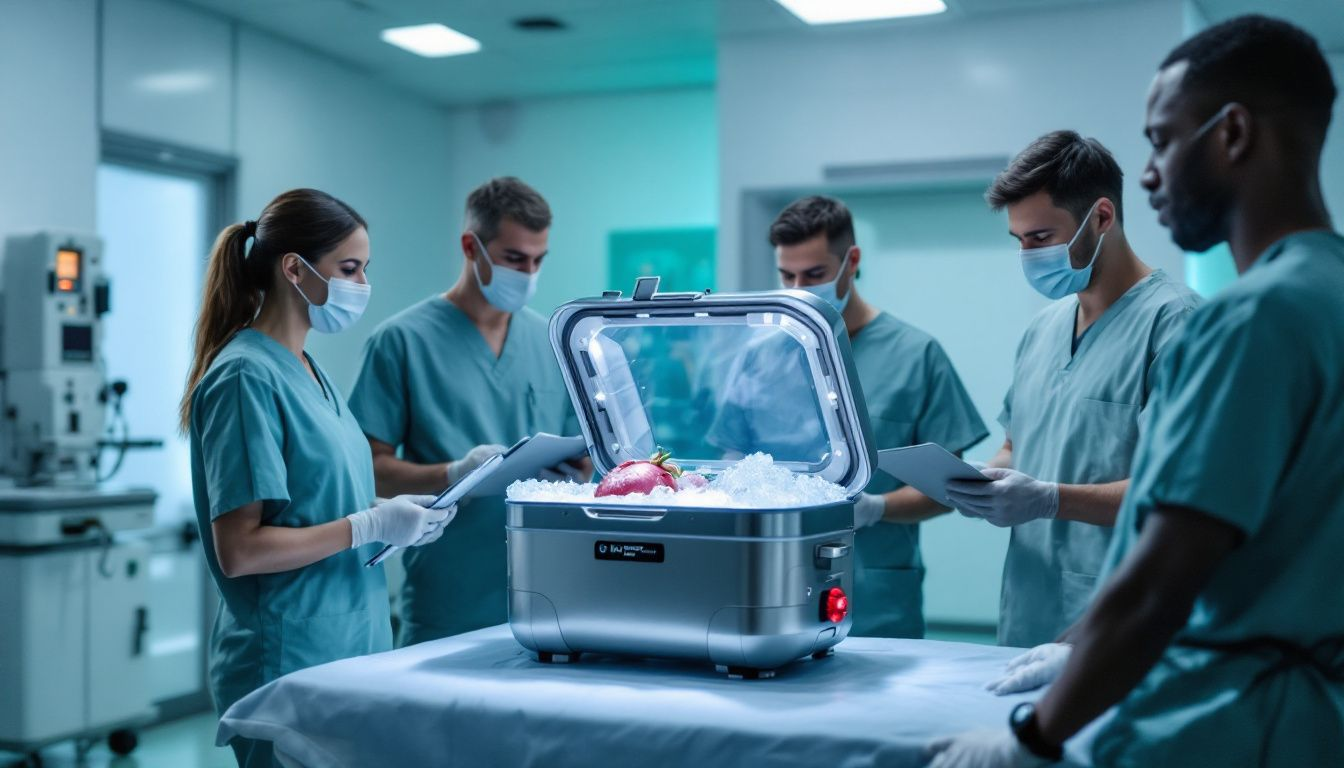Organ Transport – Innovations, Challenges, and Future Trends
Organ transport is a vital component of modern medicine, playing a crucial role in ensuring that donated organs reach patients in need while still viable. Whether through specialized vehicles, aircraft, or emerging technologies like drones, the safe and timely delivery of organs can mean the difference between life and death for transplant recipients. This article explores the intricacies of organ transport, examining the logistics, challenges, and groundbreaking innovations that are shaping the future of this life-saving process. By the end, you’ll gain insight into the technologies that preserve organ integrity, the role of transport teams, and the advancements improving efficiency in transplant logistics.
Key Takeaways
Timely organ transport is critical for transplant success, requiring effective coordination and real-time communication among medical teams to ensure organs are delivered quickly and in ideal conditions.
Specialized vehicles equipped with advanced temperature control and security measures are essential for maintaining organ integrity during transport, minimizing risks associated with temperature fluctuations and tampering.
Innovations in organ transportation technology, such as normothermic perfusion and autonomous delivery systems, are set to enhance efficiency and improve outcomes for organ transplants in the future.
Why Is Timely Organ Transport Critical?

Timely organ transport is critical because organs begin to deteriorate at a cellular level immediately after removal. Delays reduce organ viability, limiting successful transplants. Rapid transport, temperature control, and seamless coordination between transplant teams ensure organs remain functional, increasing the chance of saving lives.
How Does Time Impact Organ Viability?
Time impacts organ viability by limiting how long organs can survive without blood circulation. Hearts and lungs require transplantation within 4-6 hours, while kidneys can last 24-36 hours. Longer ischemic times increase the risk of organ failure and rejection, reducing the chances of successful transplantation.
What Are the Consequences of Delays in Organ Transport?
Delays in organ transport reduce organ viability, increasing the risk of transplant failure. Prolonged delays can render organs unusable, wasting life-saving resources. Patients face worsened health and longer wait times. Psychological stress on patients and families intensifies, and organ shortages impact the entire transplant system.
Did you know that you can get from Manhattan to JFK in under 5 minutes without driving?
Blade offers seamless helicopter transfers from our West 30th Street Lounge in Manhattan to JFK Airport in just 5 minutes from $195 per seat.
Skip the traffic and ditch the stress with Blade's year-round airport service.

What Are the Key Components of Organ Transport Logistics?
Key components of organ transport logistics include advanced technology, specialized transportation, preservation techniques, and seamless coordination between medical teams. The process of transporting organs involves recipient matching, route planning, real-time monitoring, and temperature control to ensure organ viability. Each organ's unique requirements dictate specific logistical approaches for successful delivery.
How Are Donor and Recipient Hospitals Coordinated?
Donor and recipient hospitals coordinate organ transport through organ procurement organizations (OPOs). OPOs manage communication, match organs to recipients, and oversee logistics. Transplant coordinators align surgeries, synchronize transport, and handle contingencies. This collaboration ensures timely organ recovery and delivery, maximizing transplant success.
What Role Does Communication Play in Successful Organ Delivery?
Communication ensures successful organ delivery by coordinating transplant teams, sharing real-time updates, and managing unforeseen delays. Transplant coordinators relay organ data, track transport, and align surgical schedules. Continuous communication prevents errors, fosters collaboration, and maximizes the organ’s viability during transport.
How Is Real-Time Monitoring Used During Organ Transport?
Real-time monitoring tracks organ transport by measuring temperature, humidity, and location. Sensors in transport containers alert teams to deviations, preserving organ viability. GPS systems provide live updates, allowing precise coordination with recipient hospitals. This technology ensures rapid intervention, reducing risks and enhancing transplant success rates.
How Organ Transport Companies Drive Transplant Success?
Organ transport companies play a vital role in transplant logistics by coordinating the rapid movement of organs via ground and air. They ensure compliance with medical standards, provide temperature-controlled vehicles, and use GPS tracking for real-time monitoring. These services minimize ischemic time, enhancing organ viability and transplant success rates.
Do Advanced Vehicles Support Organ Transport?
Yes, advanced vehicles support organ transport by maintaining precise temperatures, ensuring organ viability during transit. These vehicles feature temperature control systems, thermal insulation, and GPS tracking. Backup power and redundant cooling prevent failures, while specialized drivers ensure fast, secure delivery. Air transport options provide rapid solutions for long-distance transfers.
What Specialized Features Do Organ Transport Vehicles Have?
Organ transport vehicles feature advanced temperature control, thermal insulation, and redundant cooling systems to preserve organ viability. Vibration-dampening, real-time GPS tracking, and tamper-proof security ensure safe transport. Emergency lighting and specialized compartments allow multi-organ transport. Emergency organ transport vehicles ensure organs arrive intact and ready for transplantation.
What Are the Best Cold Storage Solutions for Organ Transport?
The best cold storage solutions for organ transport include medical-grade coolers, dry ice, and advanced perfusion devices like the TransMedics Organ Care System. These technologies maintain stable temperatures (4°C to 8°C) to preserve organ viability. Hypothermic preservation bags and onboard refrigeration units further ensure organ integrity during transit. Below is a comprehensive exploration of the best cold storage solutions currently utilized for organ transport.
1. Medical-Grade Coolers for Organ Preservation
Medical-grade coolers are essential for organ transport, maintaining stable temperatures between 4°C and 8°C to preserve organ viability. These coolers feature advanced insulation, airtight seals, and portability, ensuring reliability during ground or air transport. Cost-effective and widely accessible, they provide double-layered protection for short to medium-range organ transport.
2. Using Dry Ice for Extended Organ Transport
Dry ice extends organ preservation for long-distance transport by maintaining ultra-cold temperatures (-78.5°C). It provides prolonged cooling, ensuring organ viability during extended journeys. Dry ice is used with medical coolers to enhance temperature stability, but careful monitoring is required to prevent ice crystal formation that may damage tissues.
3. Hypothermic Preservation Bags for Secure Organ Transport
Hypothermic preservation bags protect organs during transport by providing a sterile, temperature-controlled environment that prevents contamination and reduces cellular deterioration. These bags use preservation solutions to hydrate organs and slow metabolic activity. Compatible with various organ types, they enhance transport reliability and extend organ viability for transplantation.
4. Onboard Refrigeration Units for Organ Transport Vehicles
Onboard refrigeration units in organ transport vehicles maintain temperatures between 4°C and 8°C, preserving organ viability during long-distance transit. These units feature real-time monitoring, automated adjustments, and backup systems to prevent disruptions. By ensuring stable, sterile conditions, they reduce ischemic damage and enhance transplant success rates.
What Innovations Are Shaping Cold Storage Technology?
Innovations in cold storage technology include normothermic perfusion devices like the TransMedics Organ Care System (OCS), supercooling techniques, and hypothermic organ perfusion (HOP). These systems extend organ viability by simulating body conditions or preventing ice formation. Smart containers with real-time monitoring enhance transport reliability, improving transplant success.
Do Transplant Teams Facilitate Organ Transport?

Yes, transplant teams facilitate organ transport by coordinating organ recovery, preservation, and delivery. They manage communication, oversee surgical retrieval, and ensure safe transport through logistics providers. Transplant teams use cold storage, GPS tracking, and real-time monitoring to protect organs, minimizing delays and maximizing transplant success rates.
How Do Transplant Teams Coordinate with Hospitals and Operating Rooms?
Transplant teams coordinate with hospitals and operating rooms by managing pre-notifications, real-time organ tracking, and surgical readiness. They ensure operating rooms are prepared, synchronize arrival times, and develop contingency plans for delays. This seamless coordination maximizes organ viability and increases transplant success rates.
Did you know that you can get from Manhattan to JFK in under 5 minutes without driving?
Blade offers seamless helicopter transfers from our West 30th Street Lounge in Manhattan to JFK Airport in just 5 minutes from $195 per seat.
Skip the traffic and ditch the stress with Blade's year-round airport service.

What Challenges Affect Organ Transport Efficiency?
Challenges affecting organ transport efficiency include coordination between hospitals, long-distance logistics, organ preservation limits, and external factors like weather and traffic. In regions where donor hospitals are located far from transplant centers, long-distance organ transport is often necessary. Air transport may be required to bridge these gaps, adding layers of complexity to the process. Delays increase ischemic time, risking organ viability. Advanced preservation systems, AI, and drones are improving transport efficiency, reducing risks, and enhancing transplant success rates.
What Is the Role of Distance and Time Management in Organ Viability?
Distance and time management are critical to organ viability, as organs deteriorate quickly after removal. Short ischemic windows for hearts transported for transplant is (4-6 hours) and lungs require fast transport, often via medical aircraft. Coordination, GPS tracking, and real-time communication minimize delays, ensuring organs reach recipients in optimal condition.
Do Weather and Traffic Conditions Impact Organ Transport?
Weather and traffic impact organ transport by causing delays that reduce organ viability. Severe weather can cancel flights or block roads, while traffic congestion increases ischemic time. Transplant teams use GPS, real-time tracking, and emergency clearances to mitigate these risks, ensuring organs reach recipients quickly and safely.
What Are the Innovations Transforming Organ Transport?

Innovations transforming organ transport include normothermic perfusion systems, drones, AI logistics, and smart transport containers. Perfusion systems keep organs alive during transport, drones reduce delivery time, and AI optimizes routes. Cryopreservation and supercooling extend organ viability, enhancing transplant success and increasing the organ pool.
How Is AI Improving Organ Transport Efficiency?
AI improves organ transport efficiency by optimizing route planning, predicting delays, and automating organ matching. AI systems analyze traffic, weather, and flight data in real-time, rerouting transport to minimize ischemic time. Smart transport containers with AI-driven monitoring ensure stable conditions, enhancing organ viability and transplant success rates.
What Role Do Drones Play in Organ Delivery?
Drones improve organ delivery by reducing transport times, bypassing traffic, and providing direct routes. Equipped with temperature-controlled compartments and GPS tracking, drones ensure organs remain viable during transit. Successful drone deliveries of kidneys and lungs demonstrate their potential to enhance transplant logistics and save lives.
What Are the Future Trends in Organ Transportation?
Future trends in organ transportation include autonomous delivery drones, AI-driven route optimization, temperature-controlled containers, and real-time monitoring systems. Drones reduce transport times, while smart containers maintain organ viability. AI predicts delays and optimizes organ matching, enhancing transplant efficiency and saving more lives.
Bottom Line: Organ Transport
The journey of a donated organ from donor to recipient is a testament to the power of modern medicine and human compassion. Innovations in organ transport technology, from specialized vehicles to advanced cold storage solutions, have revolutionized the process, ensuring that organs remain viable and ready for transplantation. The role of transplant teams, the importance of timely coordination, and the impact of external factors like weather and traffic all play crucial roles in this delicate process.
As we look to the future, the potential for further advancements in organ transport is immense. Autonomous delivery drones, real-time monitoring systems, and innovative preservation techniques promise to enhance the efficiency and success rates of organ transplants, ultimately saving more lives. The stories of donors and recipients remind us of the profound impact of organ donation, inspiring us to continue striving for excellence in this life-saving field.
FAQs about Organ Transport
What Is Organ Transport and How Is It Managed?
Organ transport refers to the process of moving donated organs from a donor hospital to a recipient facility for transplantation. Organ transport is managed through a combination of medical logistics companies, transplant coordinators, and specialized vehicles that ensure the organ remains viable throughout the journey.
How Are Organs Kept Safe During Transport?
Organs are kept safe during transport by using temperature-controlled containers, preservation fluids, and real-time monitoring systems. Keeping organs safe involves maintaining stable temperatures and sterile environments to prevent contamination or degradation.
What Determines the Mode of Transport for Organs?
The mode of organ transport is determined by factors such as distance, urgency, and the type of organ being transported. For shorter distances, ground ambulances or specialized vehicles are used, while aircraft are preferred for long-distance or time-sensitive deliveries.
Why Are Some Organs Transported by Helicopter or Private Jet?
Some organs are transported by helicopter or private jet due to the time-sensitive nature of organ transplants. Helicopters and jets enable faster transport, bypassing traffic and minimizing delays that could compromise organ viability.
What Happens If an Organ Is Delayed During Transport?
If an organ is delayed during transport, real-time tracking systems alert the transport team to address the issue. Organ delays are mitigated by backup transport plans and alternative routes to ensure the organ reaches its destination within the viable time frame.
Who Oversees the Logistics of Organ Transport?
The logistics of organ transport are overseen by organ procurement organizations (OPOs), transplant coordinators, and medical transport services. These teams manage the organ’s journey from retrieval to delivery, ensuring compliance with medical protocols.
How Are Organs Protected from Damage During Transport?
Organs are protected from damage during transport by vibration-dampening technology, shock-absorbing containers, and secure packaging. Organ protection also involves redundant cooling systems to prevent temperature fluctuations.
How Is Organ Transport Across International Borders Handled?
Organ transport across international borders requires special clearances, customs documentation, and coordination with international medical agencies. Transporting organs internationally involves using medical aircraft to expedite delivery and minimize delays.
What Backup Systems Are in Place for Organ Transport Vehicles?
Backup systems for organ transport vehicles include dual refrigeration units, battery backups, and GPS tracking. These systems ensure continuous monitoring and temperature control, preventing failures that could compromise organ viability.
How Can Blade MediMobility Improve Organ Transport?
Blade MediMobility offers on-demand, fast medical air transport to ensure organs are delivered efficiently, bypassing traditional traffic and delays. By utilizing Blade, hospitals and transplant teams can secure rapid, reliable organ transport, significantly reducing ischemic time and improving transplant success rates.
Disclaimer:
Please be aware that the content on this page has been generated by using artificial intelligence language models and may contain errors, inconsistencies, or outdated information. It is provided as-is without any warranties or guarantees of accuracy. We strongly recommend using this content as a starting point for further research. We disclaim any liability for damages or losses resulting from the use or reliance on this content.